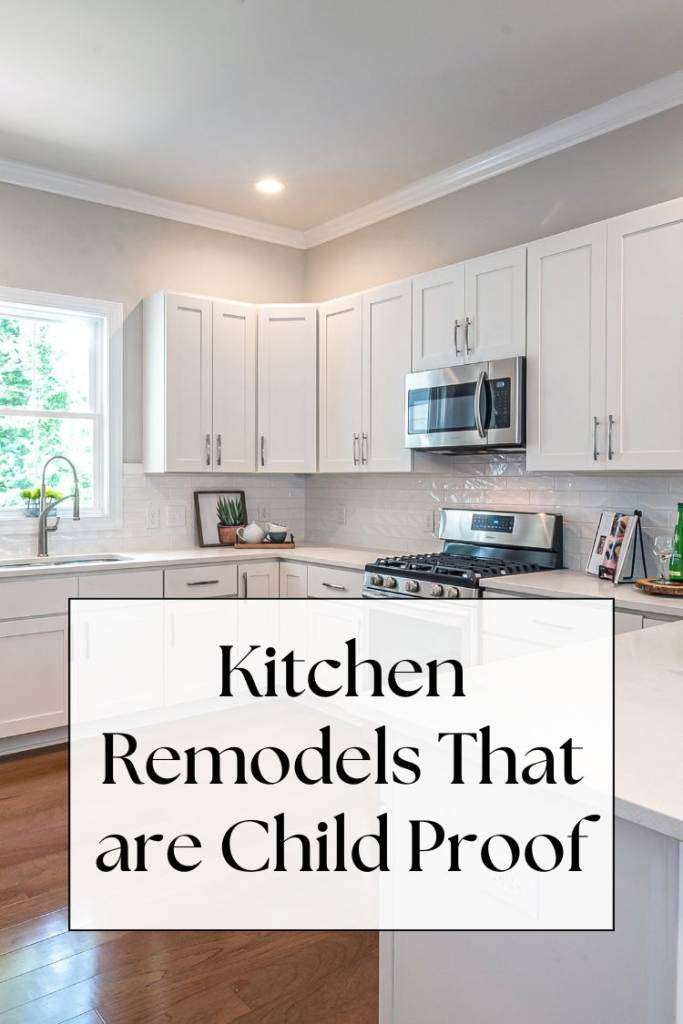Creating a family-friendly kitchen isn’t just about aesthetics – it’s about crafting a space that’s both beautiful and safe for your little ones. While kitchen and bathroom cabinet refacing can give your space an instant facelift, a truly child proof kitchen remodel requires thoughtful planning that goes beyond surface-level changes.

The Heart of Safety: Layout and Design
The foundation of a child-safe kitchen begins with smart layout decisions. Consider creating designated “zones” that naturally keep children away from dangerous areas. A kitchen island can serve as both a natural barrier and a supervision spot, allowing parents to maintain eye contact with children while cooking. Installing a breakfast nook or homework station at the periphery of the kitchen gives children a safe space to be near family activities without being in harm’s way.
Countertops and surfaces should feature rounded corners rather than sharp edges. Quartz and solid surface materials not only provide durability but also eliminate the need for sealing, making them more hygienic for young families. Choose materials with slight texture to reduce the risk of slipping when inevitable spills occur.
Smart Storage Solutions
Storage design plays a crucial role in kitchen safety. Lower cabinets should incorporate child-proof locks, but the real innovation comes in how you organize your space. Consider installing pull-out drawers instead of deep cabinets – they eliminate the need for reaching into dark corners and make it easier to keep dangerous items out of reach. Upper cabinets should be reserved for items that pose risks to children, such as cleaning supplies, sharp utensils, and breakable dishes.
When undertaking kitchen and bathroom cabinet refacing, opt for door styles that won’t trap little fingers. Flat-panel or Shaker-style cabinets minimize pinch points and are easier to clean than ornate designs. Soft-close hinges prevent slamming and protect small hands from getting caught between closing doors.
Appliance Placement and Selection
Strategic appliance placement can dramatically improve kitchen safety. The microwave should be installed at adult height but not so high that removing hot items becomes dangerous. Consider a microwave drawer installed in a lower cabinet – it’s accessible to adults but can be locked when necessary. Refrigerator water dispensers should have child locks, and ice makers should be disabled or placed out of reach.
Induction cooktops are increasingly popular in family kitchens because they only heat magnetic cookware, leaving the surface cool to touch. If gas or traditional electric is preferred, install control locks and ensure knobs are out of reach or removable. Wall ovens installed at adult height prevent children from accessing hot surfaces or climbing on open oven doors.
Flooring That Forgives
Flooring choice impacts both safety and maintenance. Cork flooring provides a slightly cushioned surface that’s easier on little feet and more forgiving when items are dropped. It’s also naturally antimicrobial and warm to the touch. Luxury vinyl planks offer similar benefits with superior water resistance and durability. Whatever material you choose, ensure it has adequate slip resistance and avoid high-gloss finishes that can become treacherous when wet.
Lighting and Visibility
Proper lighting is essential for safety but often overlooked in kitchen remodels. Under-cabinet lighting eliminates shadows on work surfaces, while motion-sensor lights in lower cabinets help prevent trips and falls when accessing storage areas. Task lighting should be bright but not glaring, and natural light should be maximized whenever possible.
Smart Technology Integration
Modern kitchens can leverage technology for enhanced safety. Smart outlets can be controlled via smartphone, allowing parents to disable power to dangerous appliances when not in use. Water sensors can detect leaks before they become slip hazards, and smart faucets can prevent scalding with temperature controls and automatic shut-offs.
Ventilation and Air Quality
A child-proof kitchen must consider air quality. Install a powerful range hood that effectively removes cooking fumes and particles. Choose low-VOC materials for cabinets and countertops to minimize off-gassing. Include adequate ventilation near the trash and recycling area to prevent odors and bacterial growth.
Maintenance and Cleaning Considerations
Choose materials and finishes that make cleaning easier and more effective. Antimicrobial surfaces, touchless faucets, and easy-clean stovetops reduce the need for harsh chemicals. Install a central vacuum system with toe-kick sweepers to make quick cleanups easier and prevent the need for leaving cleaning tools accessible to children.
Future-Proofing Your Investment
While focusing on child safety, remember that your kitchen should adapt as your family grows. Include features that will remain useful as children age, such as adjustable height work surfaces and removable step stools. Consider how safety features can be modified or disabled when no longer needed without requiring major renovations.
Creating a child-proof kitchen doesn’t mean sacrificing style or functionality. By carefully considering each element of your remodel through the lens of safety, you can create a space that works for everyone in your family. The key is balancing immediate safety needs with long-term usability, ensuring your investment continues to serve your family well as it grows and changes. With thoughtful planning and design, your kitchen can be both a showpiece and a safe haven for your most precious family members.